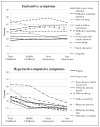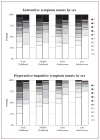Persistence of Parent-Reported ADHD Symptoms From Childhood Through Adolescence in a Community Sample
- PMID: 24994874
- PMCID: PMC4474771
- DOI: 10.1177/1087054714539997
Persistence of Parent-Reported ADHD Symptoms From Childhood Through Adolescence in a Community Sample
Abstract
Objective: To examine ADHD symptom persistence and factors associated with elevated symptom counts in a diverse, longitudinal community-based sample.
Method: Parents reported demographics and completed a diagnostic interview repeatedly over a 6-year period. At Time 1, 481 interviews were completed about children (5-13 years); all participants were invited to four annual follow-up interviews, and 379 (79%) completed at least one. Inattentive (IA) and hyperactive-impulsive (HI) symptom counts were modeled with logistic quantile regression, while accounting for study design complexities.
Results: The prevalence of seven IA symptoms remained stable from early childhood through late adolescence. The prevalence of eight HI symptoms decreased by more than half over time. After demographic adjustment, the upper quartile of HI symptom counts decreased with age (p < .01). High HI symptom counts persisted more among those with high IA symptom counts (p = .05).
Conclusion: This study further characterizes and provides insights into ADHD symptom trajectory through adolescence.
Keywords: attention deficit hyperactivity disorder; development; persistence.
© The Author(s) 2014.
Conflict of interest statement
The author(s) declared no potential conflicts of interest with respect to the research, authorship, and/or publication of this article.
Figures
References
-
- Akinbami LJ, Liu X, Pastor PN, Reuben CA. Attention deficit hyperactivity disorder among children aged 5–17 years in the United States, 1998–2009. NCHS Data Brief. 2011;70:1–8. - PubMed
-
- American Academy of Pediatrics’ Subcommittee on Attention-Deficit/Hyperactivity Disorder Steering Committee on Quality Improvement and Management. ADHD: Clinical practice guideline for the diagnosis, evaluation, and treatment of attention-deficit/hyperactivity disorder in children and adolescents. Pediatrics. 2011;128:1–16. - PMC - PubMed
-
- American Psychiatric Association. Diagnostic and statistical manual of mental disorders. 4. Washington, DC: Author; 1994.
-
- American Psychiatric Association. Diagnostic and statistical manual of mental disorders. 4. Washington, DC: Author; 2000. text rev.
-
- American Psychiatric Association. Diagnostic and statistical manual of mental disorders. 5. Washington, DC: Author; 2013.
MeSH terms
Grants and funding
LinkOut - more resources
Full Text Sources
Other Literature Sources
Medical



